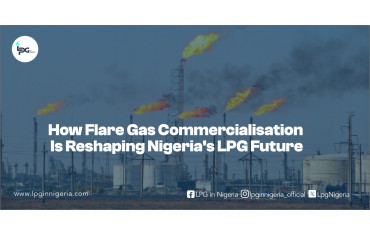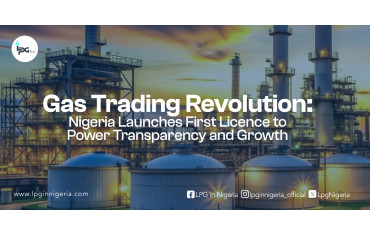- 3247
- 0
Sharing Ideas and Updates on LPG in Nigeria and related information to enable effective collaboration within the LPG Value Chain
AFRICAN ENVIRONMENT DAY - Increasing Energy Supply Through Lower Carbon Infrastructure Projects.

Africa Environment Day, observed on March 3rd each year, was established by the Organization for African Unity in 2002 to raise awareness of the continent's pressing environmental challenges. As a result, LPG in Nigeria recalls former Vice President Osinbanjo's speech on the cumulative global carbon emissions in Africa on September 22, 2022.
Former Nigerian Vice President Yemi Osinbajo said African nations account for less than one percent of cumulative global carbon emissions. According to him, the activities of wealthier nations triggered the most hostile impacts of climate change on the continent. The former vice president further stated that most countries, including Nigeria, agreed that there was the need to reduce global emissions to zero in Nigeria’s case by 2060.
“We are major victims of the effects of climate change, but there are a few important issues that we have flagged to our wealthier brother-countries in the global north,” stated Mr Osinbajo. “The first is that we, in the developing world, are faced with two, not one crisis; one is climate change, and the other is extreme poverty, the cause and consequence of which is energy poverty.”
He added, “Or the fact that lack of access to electricity for millions is a cause of deepening poverty. The second is that African countries are the least emitters of carbon today – less than one per cent of cumulative CO2 emissions and even if we triple electricity and LPG consumption in African countries (aside from South Africa) solely through the use of natural gas, this would add just 0.6 per cent to global emissions.”
According to him, the proposals to ban the funding of fossil fuel projects make no distinction between upstream oil and coal exploration and gas power plants for grid balancing. Stating that no economy in the world had been known to use renewables solely to industrialise, as solar power did not have the base load capacity yet for industry.
Africa’s oil and gas industry is entering a new era. As the world looks to accelerate its transition away from fossil fuels, the pressures on the continent’s oil and gas producing nations are mounting. McKinsey analysis has found that most African nations are highly exposed to the global energy transition, as their economies depend on oil and gas revenues, while their reserves both cost more to produce and are, on average, more carbon-intensive than oil and gas from other regions.
At the same time, energy demand on the continent threatens to outstrip supply. Over the next two decades, rapid population growth and industrialization are expected to drive strong energy demand growth across the continent—including fossil fuels. McKinsey modeling estimates that African energy demand in 2040 could be around 30 percent higher than it is today, compared with a 10 percent increase in global energy demand. Click here to see charts and figures on this assertion.
Recommendations According to Mckinsey
Increasing Energy Supply Through Lower-Carbon Infrastructure Projects
As Africa’s demand for energy increases, the need for projects that boost energy supply on the continent will likely rise, notably in the core demand centers of its larger economies: Egypt, Nigeria, and South Africa. Investment in lower-carbon-energy infrastructure projects, especially gas pipelines, processing infrastructure, and liquified petroleum gas (LPG), could enable African countries to promote intraregional trade and boost global exports of African energy products, while also helping to strengthen regional energy access. To ensure bankability, these infrastructure projects would likely need to incorporate decarbonization or carbon offset levers.
For example, McKinsey analysis suggests that despite having the largest proven gas reserves on the continent, Nigeria could find itself in a situation in which gas demand outstrips gas supply by 2030 by at least three billion cubic feet per day. This presents a potential opportunity for investment in gas infrastructure such as gas pipelines, gas processing facilities, and coastal LNG regasification to connect currently stranded gas reserves onshore and offshore with domestic industrial, commercial, and power demand centers.
Certain natural gas investments are consistent with Nigeria’s recently announced commitment to reach net zero by 2060. Our analysis indicates that Nigeria’s net-zero 2060 plan will require a significant expansion of on-grid electrification. In the short term, this will come from flexible gas-based power generation to compensate for renewables intermittency until cost-competitive, long-duration energy storage solutions become available. Expanding on-grid electricity supply via increased gas-powered generation will require investments in gas pipeline and processing infrastructure to move natural gas from its source of supply to gas-powered generation plants. Increasing on-grid electrification could also help to displace more carbon-intensive decentralized power sources; McKinsey estimates that there is between 40 and 60 gigawatts of installed capacity of diesel and petrol generators in Nigeria, generating approximately 33 metric tons of CO2-equivalent (MTCO2e) each year—12 percent of Nigeria’s total emissions.14
Countries in West and East Africa with significant gas reserves could consider developing cross-border gas pipeline infrastructure to connect to regions where gas will be in significant demand, including countries in North Africa and southern Africa. Alternatively, African countries with significant natural gas demand could invest in coastal LNG regasification plants to allow gas to be imported from other African countries with LNG export capabilities.
Looking globally, there is also potential for increased demand for natural gas resources from Africa, after the European Commission15 announced a plan to make Europe independent of Russian fossil fuels before 2030, following the invasion of Ukraine. This demand could potentially be met through investment in gas-export infrastructure such as LNG export terminals or continental gas pipeline projects to deliver African natural gas to European and other global customers.
For refined petroleum products, McKinsey analysis suggests that African demand will grow from 4.1 million barrels per day today to approximately 5.3 million barrels per day by 2040, nearly half of which will need to be imported based on existing and planned refining capacity (Exhibit 4). This could create opportunities for lower-carbon projects such as biofuels production, including bioethanol and biodiesel—to partially offset gasoline and diesel demand—or increasing LPG production, bottling, and distribution infrastructure. For example, in Nigeria, carbon-intensive cooking, such as firewood, charcoal, and kerosene, generates an estimated 37 MTCO2e per year—roughly 14 percent of Nigeria’s baseline emissions. Expanding access to LPG in Nigeria by investing in distribution infrastructure could stimulate the uptake of cleaner cooking fuels for the more than 100 million Nigerians who rely on carbon-intensive cooking fuels, while also being a potential source of carbon credits.
Culled from:
Leke, Obaseki & Onyekweli for McKinsey.















0 Comment.